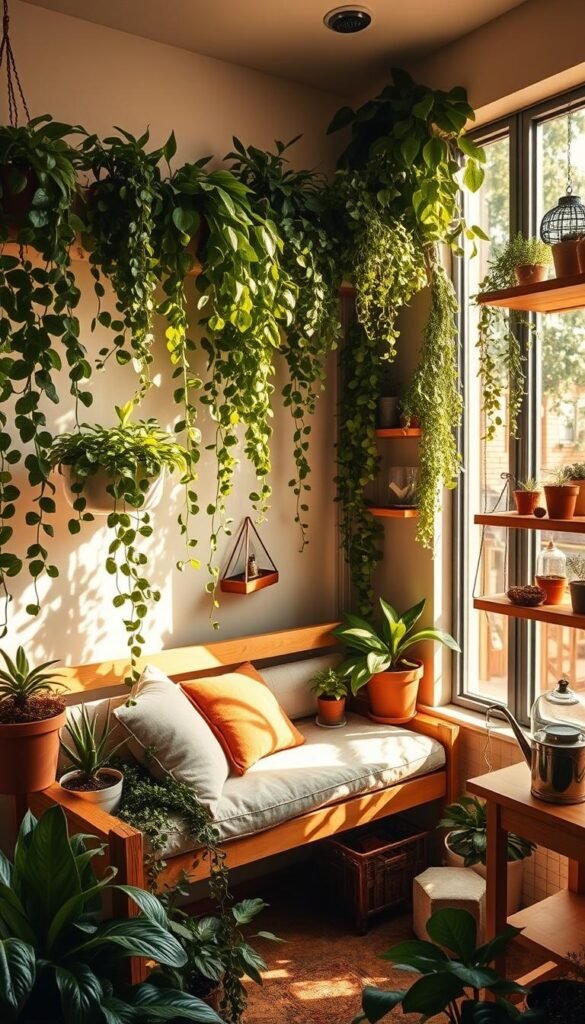Living with greenery isn’t just stylish—it’s a breath of fresh air for your mind and body. Studies show that houseplants can reduce stress and filter toxins, making your space healthier. Even better? You don’t need a backyard to enjoy these perks.
Think your apartment is too small? Think again! Compact spaces can thrive with the right greenery. From sunny windowsills to shady corners, there’s a plant for every spot. The key is choosing varieties that match your light and lifestyle.
Transforming your home into a lush retreat isn’t about having a green thumb. It’s about creativity and smart choices. Start with low-maintenance options like snake plants or pothos—they’re forgiving and grow quickly. Pair them with decorative pots to add personality to your rooms.
Urban living often means limited outdoor access, but that’s where indoor gardening shines. A few well-placed pots can turn bland corners into vibrant focal points. Imagine sipping coffee beside a cascading ivy or working next to a calming fiddle-leaf fig. That’s the magic of bringing nature inside.
Ready to dive in? This guide will walk you through everything—from selecting the best plants for your space to keeping them thriving. Let’s build your personal oasis, one leaf at a time.
Embracing the Indoor Gardening Lifestyle
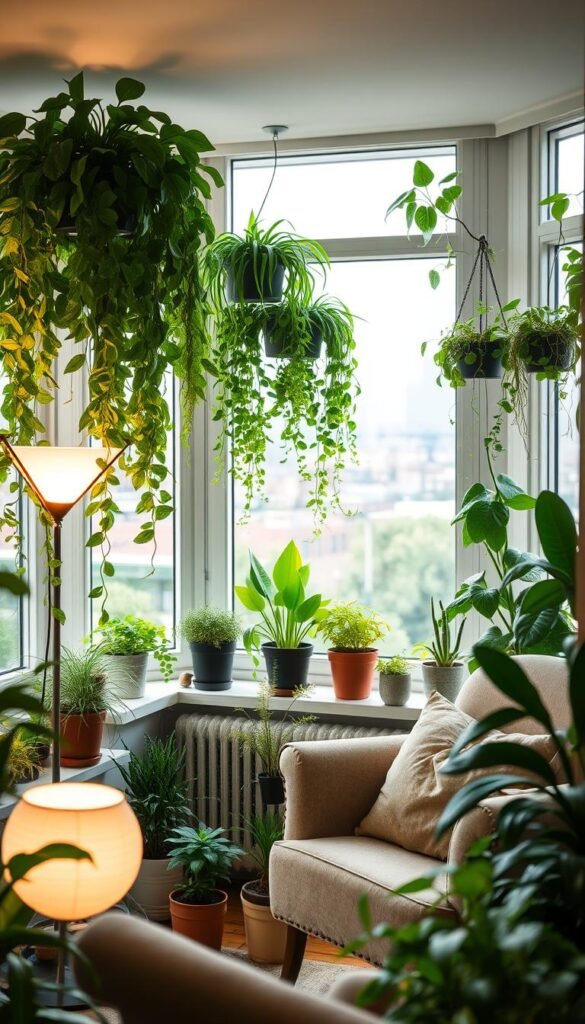
City living doesn’t mean sacrificing nature’s touch. Indoor gardening lets you weave living greenery into your daily routine, whether you’re in a studio or high-rise. It’s more than decor—it’s a way to recharge mentally while brightening your space.
Breathing cleaner air becomes effortless with air-purifying plants like peace lilies or spider plants. Studies reveal they remove toxins while boosting oxygen levels. But the perks go beyond physical health—caring for greenery reduces anxiety and sharpens focus.
This practice also teaches patience. Watching a seedling grow or propagating cuttings offers quiet joy. Many find it becomes a mindful ritual, replacing screen time with nurturing moments. Plus, you can grow herbs like basil or mint for cooking—fresh flavors at your fingertips.
| Benefit | Impact | Quick Start Tip |
|---|---|---|
| Stress Relief | Lowers cortisol levels | Try a low-light ZZ plant |
| Air Quality | Filters 87% of toxins* | Add a snake plant |
| Food Production | Fresh herbs year-round | Use containers with drainage |
Urban dwellers especially thrive with this lifestyle. Even a windowsill garden connects you to nature’s rhythms. Start small—one resilient plant can spark a lifelong passion for green living.
Assessing Your Space and Light Conditions
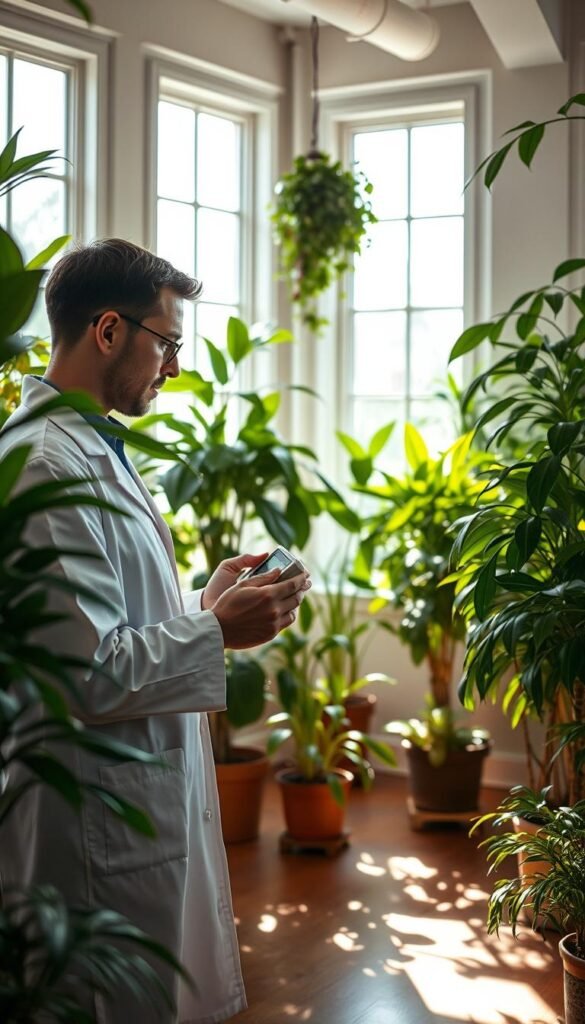
Light is the lifeblood of your indoor garden. Before choosing plants, spend a day tracking how sunlight dances through your rooms. South-facing windows soak up bright rays all day—perfect for succulents and cacti. North-facing areas? They’re ideal for ferns that shy away from harsh light.
Evaluating Natural vs. Artificial Light
Not all light is created equal. Direct sunlight beams through unobstructed windows, while indirect light filters through curtains or bounces off walls. Use your phone’s compass app to identify window directions. No sunny spots? Grow lamps mimic natural spectra—place them 12 inches above plants for 6-8 hours daily.
Identifying the Best Spots in Your Apartment
Look beyond windowsills. That empty corner by the floor-to-ceiling mirror? It reflects light, doubling brightness. Floating shelves near east-facing windows create prime real estate for herbs. For vertical growing, try hanging pothos near skylights or using ladder stands in narrow spaces.
Pro tip: Rotate pots weekly so all sides get equal light. Track seasonal changes—winter sun sits lower, altering exposure. With smart placement, even that dim bathroom can host a humidity-loving air plant.
Choosing the Right Plants for Indoor Success
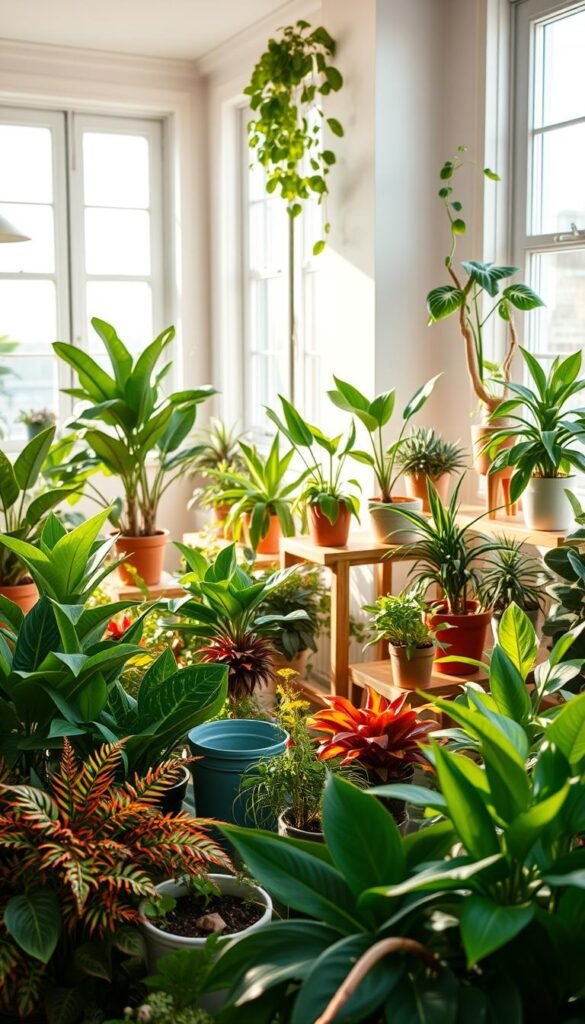
The secret to a thriving indoor garden? It starts with picking green companions that thrive in your unique environment. Not all plants adapt well to apartment living—some crave constant attention, while others flourish with minimal fuss.
Survivors That Clean Your Air
Begin with resilient varieties that multitask. Snake plants work overtime—they filter airborne toxins while surviving weeks without water. “These architectural beauties release oxygen at night, making them perfect bedroom buddies,” notes urban gardening expert Lisa Chang.
Peace lilies offer dual benefits too. Their white blooms brighten spaces while absorbing mold spores. Pair them with ZZ plants for low-light corners—their waxy leaves store water like camels store fat.
Grow-It-Forward Favorites
Pothos vines transform bookshelves into cascading jungles. Their heart-shaped leaves tolerate dim offices or sunny kitchens. Spider plants prove even better—they sprout baby offsets you can repot or share.
For those craving fresh herbs, basil and mint thrive near east-facing windows. Elevate your game with expert plant care strategies that ensure year-round growth. Remember: success lies in matching plant needs to your space’s light and airflow.
Maximizing Your Apartment’s Vertical Space
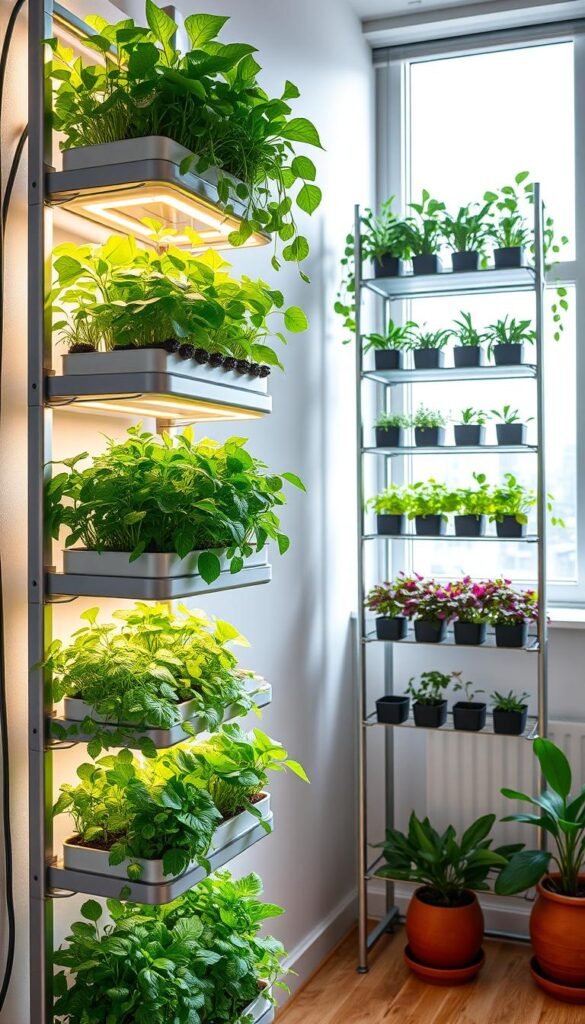
When floor space is limited, look up—your walls and ceilings hold untapped potential for greenery. Vertical gardening turns blank surfaces into lush canvases, adding depth and life to compact areas.
Shelves That Double as Plant Stages
Floating shelves create dynamic displays. Stagger them at different heights to showcase trailing ivy, chunky succulents, or colorful container gardening flowers like petunias in shallow pots. Mix ceramic and woven planters for contrasting textures that catch the eye.
Ladder stands offer tiered elegance. Lean one against a sunlit wall to display air plants on its rungs and snake plants at the base. “They’re perfect for renters—no drilling required,” notes Brooklyn plant stylist Mara Lin.
Hanging Gardens That Float
Ceiling hooks transform dead space into aerial jungles. Try macrame hangers with spider plants whose babies cascade downward. For kitchens, hang herb baskets near windows using tension rods—basil and thyme within arm’s reach.
Wall-mounted systems let you grow vertically with style. Modular panels host pockets of strawberries or philodendrons, turning plain walls into edible art. Rotate pots seasonally to keep the design fresh and thriving.
Pro tip: Combine hanging and shelf displays. Place trailing pothos above shelves holding upright zz plants. This layered approach adds movement while maximizing every inch.
Hacking Light Sources and Innovative Grow Lights
Bright ideas can turn even the dimmest corners into thriving plant zones. Start by placing mirrors behind your greenery—they bounce sunlight like nature’s amplifiers. A well-positioned reflective surface doubles available light for ferns or monsteras in shadowy areas.
When natural sunlight falls short, modern grow lights save the day. Full-spectrum LED strips mimic dawn-to-dusk conditions, while clip-on bulbs target specific plants. “These tools let you create custom sunrises for your urban jungle,” explains horticulturist Lisa Chang.
| Grow Light Type | Best For | Daily Use | Placement Tip |
|---|---|---|---|
| Full-spectrum bulbs | Flowering plants | 12-14 hours | 12″ above leaves |
| LED strips | Herb gardens | 8-10 hours | Under shelves |
| Clip-on lamps | Single specimens | 6-8 hours | Adjustable arms |
Rotate pots every Sunday during watering. A quarter-turn prevents lopsided growth as plants reach toward light sources. South-facing windows work best for succulents, while peace lilies thrive in eastern exposures.
Wipe leaves monthly with a damp cloth—dust blocks 30% of sunlight absorption. Clean windows seasonally too. Pair these hacks with smart placement, and watch your green friends flourish.
Self-Watering Systems for Stress-Free Plant Care
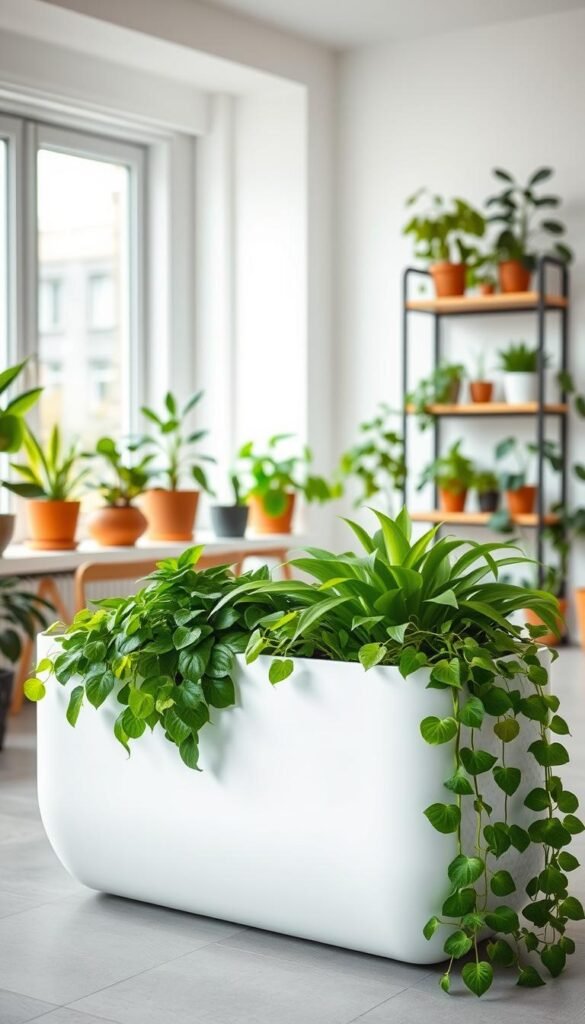
Keep your greenery thriving without daily attention using smart hydration solutions. These clever setups deliver water precisely when your plants need it—perfect for work trips or packed schedules.
DIY Self-Watering Hacks
Transform everyday items into plant care heroes:
- Wine bottle irrigation: Fill an empty bottle, invert it into soil. Gravity feeds moisture as the earth dries
- Mason jar wicks: Connect jar water to soil through cotton ropes using capillary action
- Plastic bottle drippers: Bury punctured caps neck-down for slow-release hydration
Modern Pot Designs with Built-In Reservoirs
Upgrade your container game with these innovations:
| Style | How It Works | Best For |
|---|---|---|
| Reservoir planters | Roots draw from water chambers below | Peace lilies, pothos |
| Capillary mats | Felt layers wick moisture upward | Seedlings, herbs |
| Smart pots | App alerts when to refill tanks | Orchids, fiddle-leaf figs |
These systems prevent root rot by avoiding soggy soil. “Plants drink at their own pace,” notes urban gardener Tyler Moss. “You gain weeks between refills.”
Pair these hacks with decorative containers, and you’ll save time while keeping leaves perky. Perfect for forgetful waterers or frequent travelers!
Creating the Ideal Humidity Environment for Your Plants
Your leafy friends crave more than just water and light. Many popular houseplants evolved in tropical rainforests where humidity levels hover near 70%. Recreating that moist environment helps plants thrive—especially when heaters or AC dry your air.
Start simple: place pots on pebble-filled trays with water. As liquid evaporates, it gives a steady humidity boost. Grouping plants together works wonders too—their collective transpiration creates a mini jungle microclimate.
For stubbornly dry spaces, try a cool-mist humidifier near your green collection. Just keep it 3-4 feet away to prevent soggy soil. Misting works for short-term relief, but always use room-temperature water to avoid shocking leaves.
Watch for crispy leaf tips—they signal thirsty air. But don’t overcompensate by overwatering! Check soil moisture first. Proper humidity means roots drink efficiently while plant pores stay open for gas exchange.
Balancing moisture transforms your space into a vibrant ecosystem. With these tweaks, you’ll see glossier leaves and faster growth—proof your environment supports lush, happy plants.

